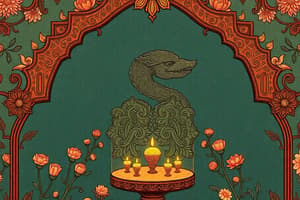Podcast
Questions and Answers
Primary colors can be formed by mixing other colors together.
Primary colors can be formed by mixing other colors together.
False (B)
Orange is a secondary color that can be created by mixing red and blue.
Orange is a secondary color that can be created by mixing red and blue.
False (B)
Tertiary colors are formed by mixing a primary color with a secondary color.
Tertiary colors are formed by mixing a primary color with a secondary color.
True (A)
The color wheel includes only primary and secondary colors.
The color wheel includes only primary and secondary colors.
Color harmony refers to the ways colors can be combined to create either harmonious or contrasting effects.
Color harmony refers to the ways colors can be combined to create either harmonious or contrasting effects.
Complementary colors are adjacent to each other on the color wheel.
Complementary colors are adjacent to each other on the color wheel.
Analogous colors create a harmonious effect because they are equally spaced on the color wheel.
Analogous colors create a harmonious effect because they are equally spaced on the color wheel.
Warm colors like red and orange are considered calming and sedative.
Warm colors like red and orange are considered calming and sedative.
In screen design, the primary colors used are red, green, and blue following the additive color model.
In screen design, the primary colors used are red, green, and blue following the additive color model.
Color theory is only relevant in art and not in other fields like marketing and psychology.
Color theory is only relevant in art and not in other fields like marketing and psychology.
Flashcards are hidden until you start studying
Study Notes
Color Theory
Color theory is a fundamental concept in visual arts and design that explains how colors interact with each other and how they can evoke moods and reactions. It involves the study of hues, tints, tones, and shades, as well as the color wheel and classifications of primary, secondary, and tertiary colors.
Primary, Secondary, and Tertiary Colors
In color theory, colors are classified into primary, secondary, and tertiary colors. Primary colors are the three fundamental colors that cannot be formed by mixing any other colors, such as red, blue, and yellow. Secondary colors are formed by mixing two primary colors, such as green (blue and yellow), orange (red and yellow), and purple (red and blue). Tertiary colors, also known as intermediate or secondary tertiary colors, are created by mixing a primary color with a secondary color, such as red-orange (red and orange).
Color Wheel
The color wheel is a circular arrangement of colors that helps us understand their relationships. It is divided into primary colors (red, blue, yellow), secondary colors (green, orange, purple), and tertiary colors (a mix of primary and secondary colors). The color wheel is a visual representation of different hues arranged in a circular order.
Color Harmony
Colors can be combined in various ways to create harmonious or contrasting effects. Some common color harmonies include complementary (opposite colors on the color wheel), analogous (adjacent colors), and triadic (equally spaced colors). Complementary colors are opposite each other on the color wheel, such as blue and orange, and create a striking contrast. Analogous colors are adjacent on the color wheel, such as yellow, orange, and red, and create a harmonious effect. Triadic colors are equally spaced on the color wheel, such as red, blue, and yellow, and create a vibrant, contrasting effect.
Color Psychology
Colors can also have psychological effects, which can greatly impact the aesthetic and emotional impact of art and design. For example, warm colors like red, orange, and yellow are considered stimulating, cheerful, and exciting, while cold colors like blue, green, and purple are considered calm, sedative, and in some cases even depressing. These psychological effects can be used to evoke specific emotions and create a desired mood or atmosphere in art and design.
Usage in Design
Color theory is used extensively in various fields, including art, design, marketing, and psychology. In visual design, color theory helps in designing harmonious, meaningful designs for users by understanding how colors interact and how they can convey specific emotions and messages. In user experience (UX) design, color choices optimize users' experience in attractive interfaces with high usability.
In screen design, designers use the additive color model, where red, green, and blue are the primary colors. When starting the design process, designers can consider using main color schemes like monochromatic (one hue and other elements from different shades and tints of it), analogous (three colors located beside one another on the color wheel), complementary (opposite colors on the color wheel), and triadic (equally spaced colors).
In conclusion, color theory is a crucial concept in visual arts and design that explains how colors interact and how they can evoke moods and reactions. It involves the study of hues, tints, tones, and shades, as well as the color wheel and classifications of primary, secondary, and tertiary colors. Color theory is used extensively in various fields, including art, design, marketing, and psychology, and understanding its principles can greatly enhance the aesthetic and emotional impact of art and design.
Studying That Suits You
Use AI to generate personalized quizzes and flashcards to suit your learning preferences.




